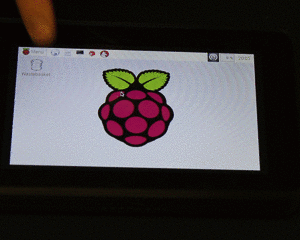

- #Egalaxtouch vs official raspberry pi touchscreen full
- #Egalaxtouch vs official raspberry pi touchscreen plus
This combined controller restricts the bandwidth for USB-based DAC connections (to external DACs) and the Ethernet throughput. Pi Versionġ.2 GHz 64-bit quad-core ARM Cortex-A53 processorģ00Mbit/sec limited by shared USB 2.0 connectionīefore the 4B version, using a Pi as a network streamer was primarily limited by the shared Ethernet and USB controller. For the sake of this discussion, we only need to concern ourselves with the most recent Pi models. The Pi’s claim to fame is, of course, inexpensive and flexible open-sourced computing power. Each revision is more powerful than the previous but shares the same basic shape and size. There have been several Raspberry Pi revisions over the last few years. There are four main hardware components in a Pi-based network streamer: Build 2 does not include an internal DAC. Componentīuild 1 (left) contains an internal DAC so output analog RCA sockets were added to the rear cover.
#Egalaxtouch vs official raspberry pi touchscreen plus
Build 1 (left) and Build 2 (right) with the Topping D10s DAC and xDuoo XD05 Plus DAC/amp.īuild 1 contains an internal DAC board but the slower Pi 3B+, while Build 2 does not include a DAC in the price (it requires an external USB DAC) and is based on the faster Pi 4B. These are fully functional and complete music streamers, but offer different options based on whether you already own an external USB DAC. I put together two recommended builds that are both priced around $250.

The great thing about a Pi-based device is that you’ve got SO MANY options and choices to make every step of the way, and the end product can be significantly different for each builder. Your list of acceptable compromises is likely quite different than my own. Throughout this guide, I’ll explain what (and why) I selected for my own build, and I’ll also provide available options for you to make your own purchase decisions. I tried to select high-quality components firmly situated in the bang-for-the-buck category. With champagne tastes and my (cheap) beer budget firmly in mind, my frugality-fueled motivation was to see how fully-featured and high-fidelity a product I could create for the least amount of money possible. And the price CAN be far less than a finished commercial product with similar features and sound quality. It’s the ultimate DIY device, allowing the average tinkerer to select components and easily combine them into a custom product.

Rather than using a multi-purpose, complicated, and inherently noisy computer to serve up digital music files, a Pi streamer can offer a streamlined and straightforward solution. Many compelling aspects of a Pi-based streamer became apparent when using the Streamer Ultra. My biggest takeaway from using a commercial Pi-based network music streamer was that I could build one myself! While I appreciated the device’s idea and sound quality, I struggled to justify the price and the compromises made in convenience and features. I recently reviewed the Orchard Audio PecanPi Streamer Ultra, a Raspberry Pi-based network music streamer device with an integrated touchscreen. I'm well pleased as QT was looking like a mountain to climb.I purchased all the components used in this guide. I now have a usable eGalax/HDMI 8 inch touch screen working under Kivy. Whichever way I do it the Kivy config.ini file needs to be updated to make it possible for end users to calibrate themselves. I am going to look at either a rewrite of ts_print_raw or a fresh Python-based calibrate program for Kivy. That said, ts_print_raw is helpful as you can get the coordinates for the four corners of the screen and plant the values into the min_abs_x, max_abs_x, min_abs_y, max_abs_y values in the Kivy config.ini file and it's almost perfect! I also required invert_x.
#Egalaxtouch vs official raspberry pi touchscreen full
The tslib utlitiy ts_calibrate does not help as it doesn't use the frame buffer correctly on my RPi - the test screen is smaller than the full screen that Kivy uses for some reason not yet identified. Having fixed this aspect of the eGalax problem the next issue is the calibration. There are lots of kivy eGalax users looking for this solution so it ought to be done. If no one else has done it I will put a request on github for a change. I downloaded the latest Kivy 1.9.1 and the options list in HIDInputMotionEventProvider has not been updated. Adding the max_abs_x etc to the config options list in HIDInputMotionEventProvider fixes the problem. I have looked everywhere for solutions to my RPi / eGalax touch screen problem. This post of yours has just saved my project - thank you!!!


 0 kommentar(er)
0 kommentar(er)
